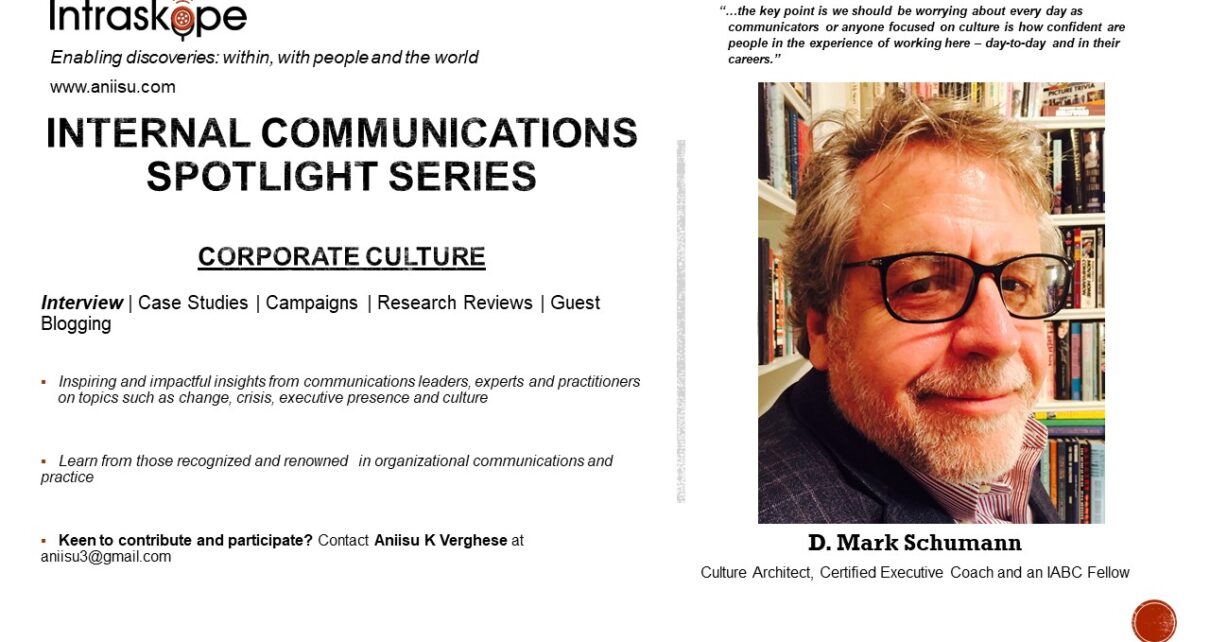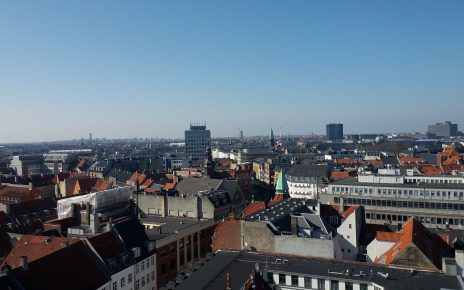Introducing the Spotlight Series on Intraskope where I interview key thought leaders on topics interrelated with internal communications such as culture, crisis, change, executive presence and leadership. The goal is to help unravel why they matter, what can leaders and communicators learn from experts and how we can put insights to practice. Watch these short interviews and get better at understanding these key topics and how you engage with internal communications.
The first episode features D. Mark Schumann, a Culture Architect, a Certified Executive Coach and an IABC Fellow. I’ve had the honor of knowing him as a colleague and friend at Sabre Corporation when he served as the VP of Culture. Mark shares his thoughts on what has and hasn’t changed with the way organizations and communicators approach culture. He advocates inspiring curiosity and encouraging conversations among employees to continue giving culture its due.
He believes strongly that culture isn’t a ‘thing’ that we do as a task. It evolves and needs to be nurtured.
“You don’t use the word – culture. I’ve said this for years. And we can talk about it. It can be our code word, for doing the right thing. It can be our code word for showing people that we care. It can be our code word for listening. But the minute we start talking too much about culture as a “thing”, it becomes a thing that we can check the box and say we’re done, we succeeded, we can move forward. You can never check the box and think you’re done”, says Mark.
Watch the complete video interview on YouTube or read the transcript below.
You can also look up the ongoing Intraskope’s Spotlight on Internal Communication Series featuring practitioners from around the globe sharing best practices and perspectives.
Interview
- You’ve worked on culture for many years. According to you over the years, what has really changed about culture? And how do companies view it?
You know, most interesting is how little has changed in terms of cultures and outcome. Culture is ultimately how it feels to work somewhere. And so that hasn’t changed. What certainly has changed are the things that can influence culture can get in the way of culture, I think the role of leadership to help shape behavior has become more intensified. But I don’t think culture itself has changed at all. It was 42 years ago, when I wrote my thesis in graduate school on culture, and how leaders of companies influenced what we then called the work environment or the work experience. We didn’t use the word culture as much. And it really hasn’t changed. Our role has not changed as communicators. What has changed is all the noise, certainly some of the pressure, and perhaps some of the institutional trust, that can get in the way of cultures that both please people, inspire people and become famous.
2. What according to you is the key role that communication place in terms of culture building?
Well, I think that there are a few things I think we have always and we continue to provide a help; provide a sense of clarity about what’s happening in an organization to make certain that everyone is operating from a unified sense of purpose and mission and strategy and concern about results. I think clarity has always been a key part of what we do. I think certainly, and I think this has become even more the case with the use of technology and where we can pull information from. I think a key part of our job is to stimulate the curiosity. We’re not the news Bureau, we’re not cub reporters, I think we are those who want to stimulate the curiosity. And so that people want to learn more on their own about the places they work and the industries they work in. So, I think that curiosity is a key part. I think more so today, because it’s more important today, we were the ones who facilitate conversations. And I think that’s probably the most important thing that we do is we need to be you know, in charge of how organizations Listen, and what organizations do with what they hear. I think that facilitating the conversation is so that people can make connections. And then I think that ultimately, the impact we have is, is on a sense of commitment that people bring to their work and to the organizations and to each other. And, you know, the contributions they make give organizations confidence. And I think that, especially when you look back at this year, and all the things that we hold on to that we can’t hold on – to the people we want to hold on to, we can’t hold on to. And I think it has done so much what’s happened to the world to dilute the competence we have in the places we live in the people we follow. I think that the key point is we should be worrying about every day as communicators or anyone focused on culture is how confident are people in the experience of working here – day-to-day and in their careers.
3. Now that we’re going through COVID19. What is your sense of how should organizations approach thinking about culture in this kind of scenario post COVID19?
I think we first we need to listen, and we need to ask people – ‘how are you doing?’ One day we went to an office and the next day, we didn’t go to an office without any idea of if we would ever return to that office. All of a sudden, I think we, as organizations have to say, as virtual as we thought we were, culture was primarily a brick and mortar experience, because it happens immediately around to me. And if those things I counted on immediately around me are no longer there, now I’m having to share them with, a partner in my life, with children, with all the people who need to use the internet with all of these changes, all of a sudden, those culture icons that we can rely on, when we all go somewhere every day, are no longer there. And so I think we have to ask – this is the most important time to listen. If we weren’t listening during we need to certainly be listening at this point. As hopefully the world comes out of this, but we need to learn how this changed us. So that we don’t instantly expect, at some magic point to say, okay, that’s over, we can go back to the way we were. Because we can’t – we won’t. And I think the key reason is because as people, we learned a lot, we’ve learned a lot from this. We’ve learned that “Oh, my goodness, I can do my job, I can be a good parent, I can be a student, I could be a husband, a wife, a partner, and I can do all these things, I didn’t realize how much I can really accomplish. And when I go back to work, I’m going to go back to work, or the physical work, if you will, if I ever go back to physical work with a greater sense of competence in what I can accomplish”. That’s a powerful thing. And organizations need to be aware of it, be sensitive and be responsive. We can’t go back to what things were like in January of 2020. That world’s gone.
4. A recent study among employees found that, they felt much more supported and received a lot more kindness during this time. What’s the connection to culture?
Well, it is, as we’ve talked about, in different conversations, and certainly have tried to bring to the places we work, culture is 99%, all about leadership. If you think about what’s happened in our world, what is really important for us to feel as people – we need to feel that leaders are in charge. It’s nice to think that leaders may have a plan, may have a strategy, may actually know how to facilitate conversations themselves. But most importantly, we want to know that leaders care. And I think that going forward, when we look at those aspects that determine if I’m willing to follow a leader, I’m going to be looking a whole lot more closely if he or she cares for people. And if he or she makes certain that the people they work with everyday care for people, I think the Care quotient is going to be a whole lot more on our minds as we move forward, simply because this experience has left us feeling so vulnerable.
5. What is your recommendation for leaders and managers to communicate culture? Because it’s hard to talk about culture – so how do you communicate it?
You don’t use the word – culture. I’ve said this for years. And we can talk about it. It can be our code word, for doing the right thing. It can be our code word for showing people that we care. It can be our code word for listening. But the minute we start talking too much about culture as a “thing”, it becomes a thing that we can check the box and say we’re done, we succeeded, we can move forward. You can never check the box and think you’re done. Because tomorrow you’ll have different people. Tomorrow, you’ll have different challenges. Tomorrow, you will have different pressures. So, the best way to talk about culture is to do what is right. And then trust that people will choose. And with those choices, create a culture where they want to work. Ultimately, leaders don’t change culture. Leaders can change themselves. They can shape themselves and people will follow. And so best way to think about culture is to think about it not to use the word too much.
6. What can organizations do to be culture ready for the future?
Have the listening systems in place. The most important point to do is to just feel that you have this ongoing sense of dialogue with your people. Then you can immediately project what you’re hearing to what’s happening in the organization and bring it to any conversation. It is for us to ask – how do you think people will react to that? And we don’t have to rely on our instinct we can reach for the insight that we’ve collected from our people. And so, listen, listen, listen, listen, listen, and catalogue and curate it and communicate it. But that that ability to be able to instantly project – how people may react is as valuable as anything we can bring.
7. What has been the hardest step for you in all these years you’ve worked in while managing and curating cultures in organizations?
Telling people NO. Or telling people it’s not over yet. I think sometimes, we believe the press about what culture is. I think there always going to be people who think it’s this program or that program, or just gimmick. These things are great window dressing, but it’s all about what’s happening inside. And it’s all about again, how people feel. And it is it is essential that we realize that it’s complex, that it’s fragile, and that it must be fed, nurtured, supported every day.
Liked the interview? Post your comments and share it with your network.
Keen to contribute and participate in the Spotlight series? Write to me at aniisu3@gmail.com
Here are Internal Communications resources you can use:
- Learn: Internal Communications Fundamentals Course on Thinkific
- Internal Communications Series: https://forms.gle/KcqmPzLwq7NQi5Km6
- Chat with Aniisu – Internal Communications: https://www.instamojo.com/intraskope/connect-with-aniisu-60-minute-personalized-d/?ref=store
- Internal Communications workshops: https://bit.ly/2zdBRl1
You can also visit my website www.intraskope.com and You Tube channel to know more about my work.
#IC #culture #internalcomms #corporateculture #internalcommunications #employeeexperience #listening #covid19 #markschumann #intraskope


